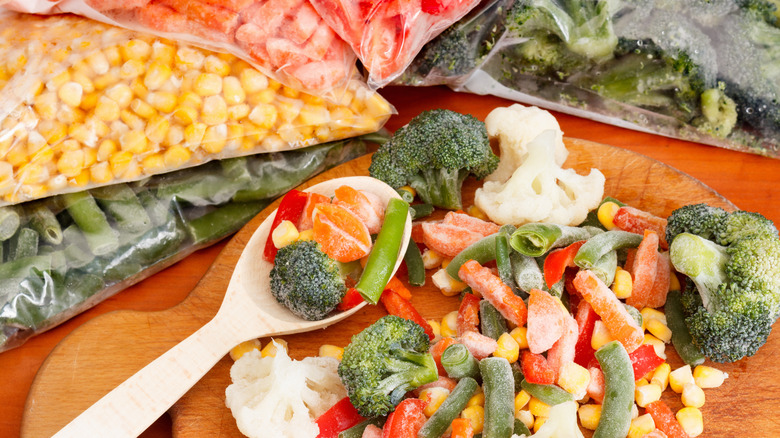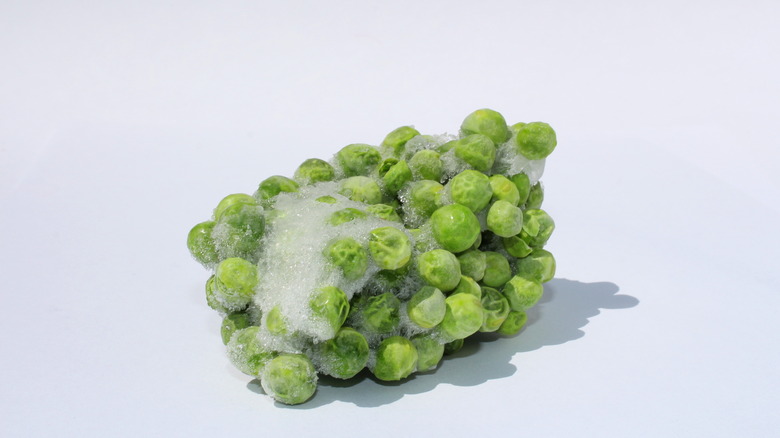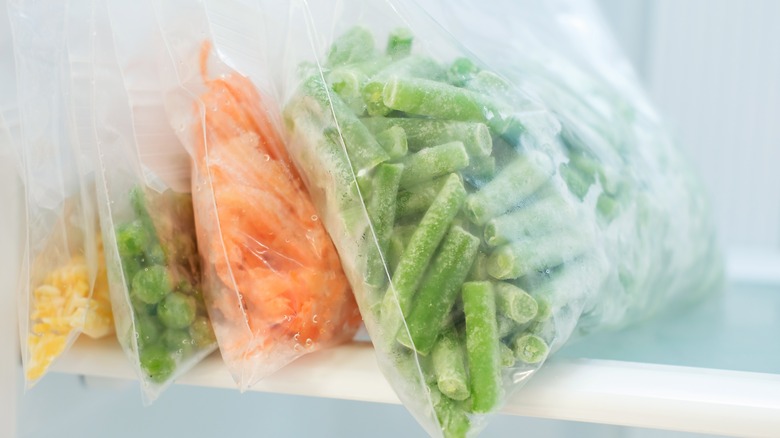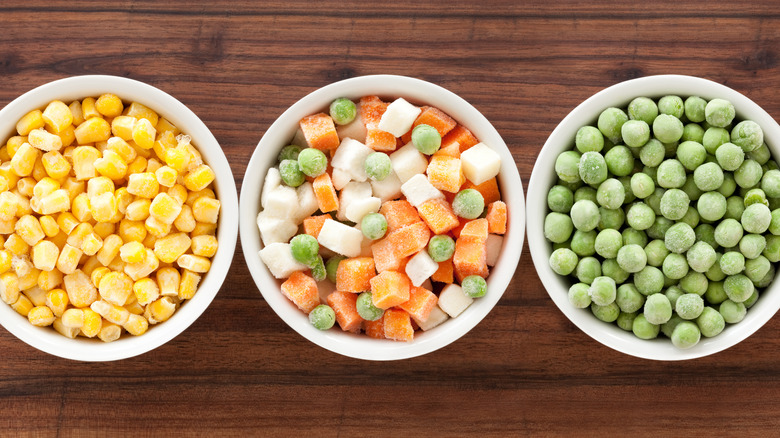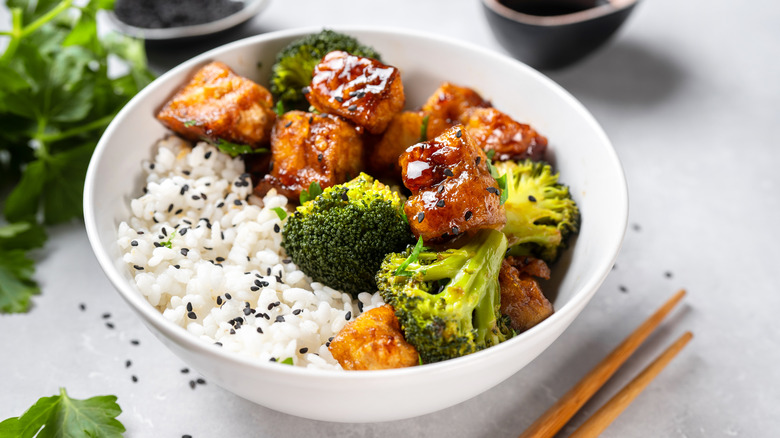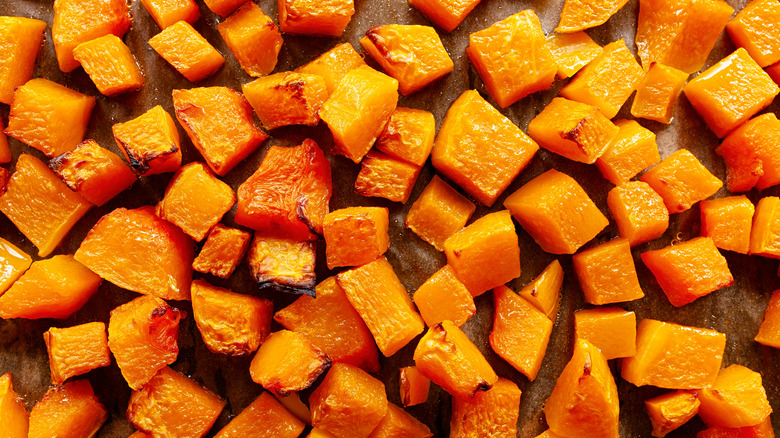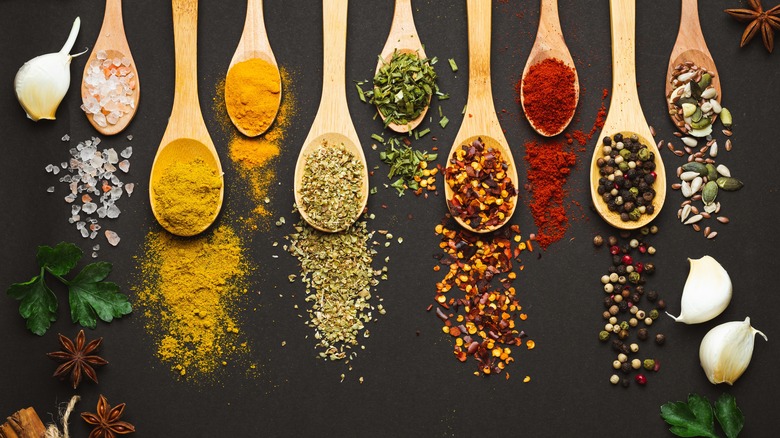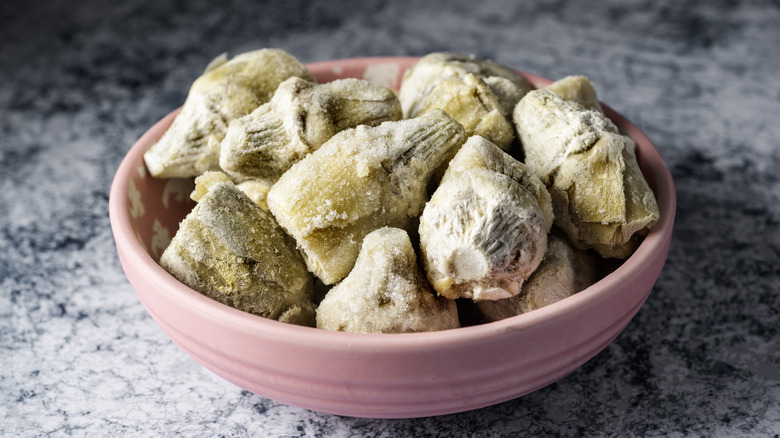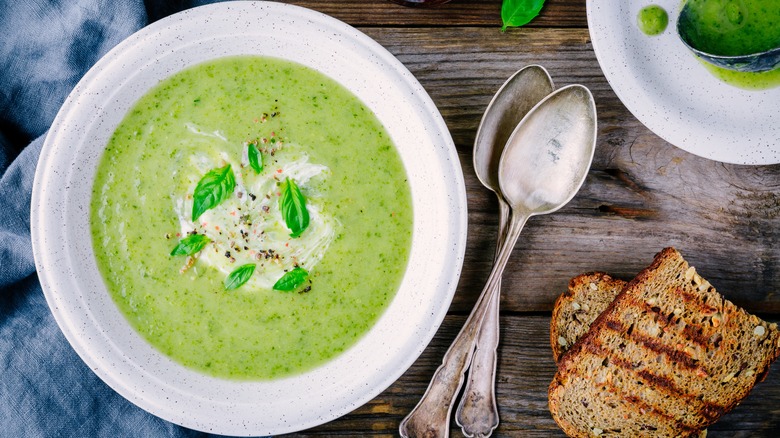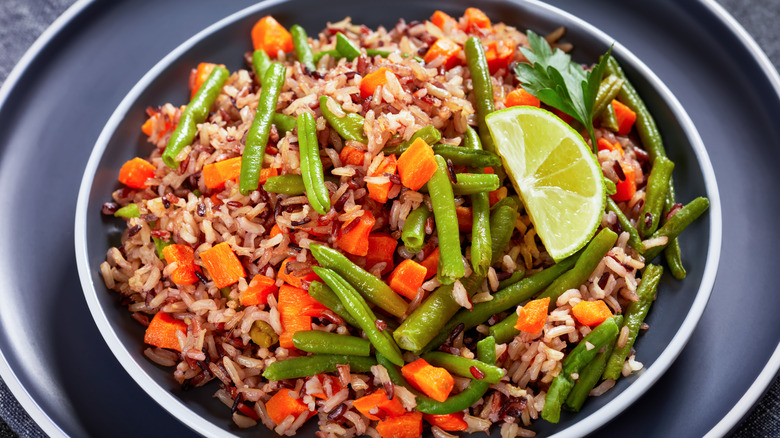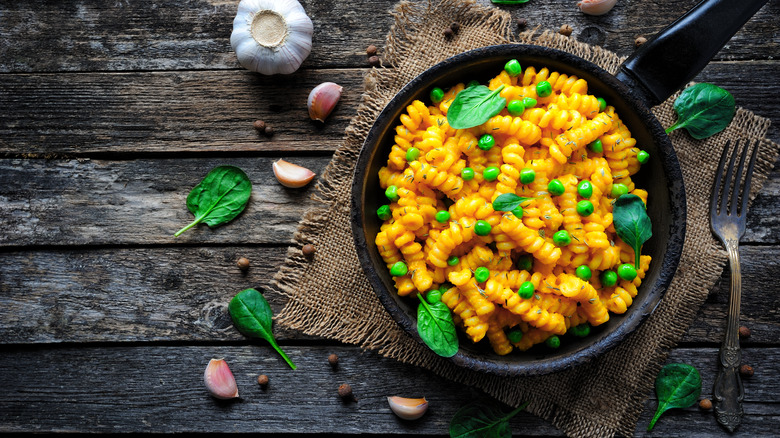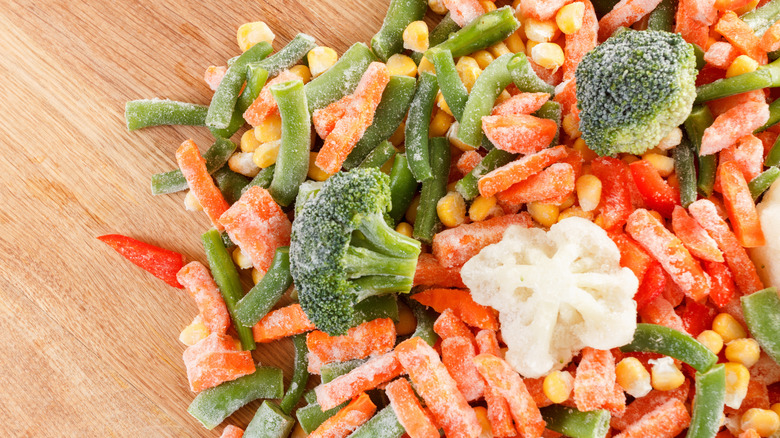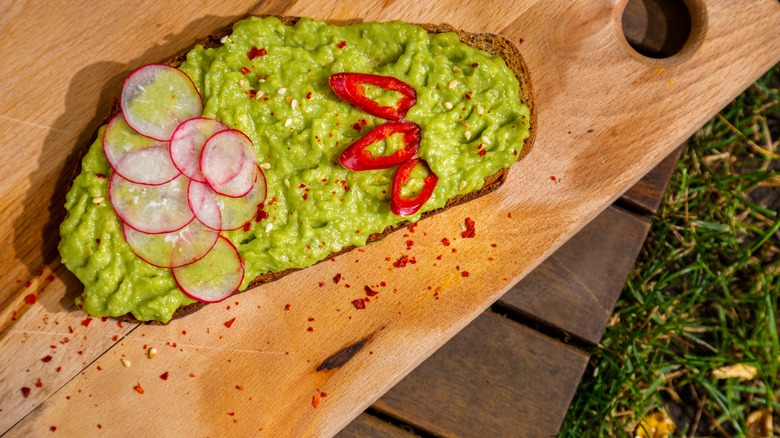Mistakes Everyone Makes With Frozen Vegetables
Frozen vegetables might not be among the most inspiring forms of produce. Few will argue that defrosted veggies look beautiful in a bowl on your countertop or make you think of late night dinners on sunny Mediterranean islands, but they sure are practical. However, despite being fairly utilitarian, frozen produce might not be as bad as you think. In fact, there are mistakes everyone makes with frozen vegetables that may have more to do with this reputation than the produce itself. Avoiding these errors can lead to better-tasting veggies and more interesting dinner options. Plus, frozen vegetables might be better for you than you think, as they're frozen quickly after being picked, locking in those all-important nutrients.
It's time to embrace the convenience of frozen options while still making drool-worthy meals. As a food writer, I do a lot of cooking, eating, and thinking about food, and I've used frozen vegetables extensively — though I have some go-tos that I use much more than others, such as peas and edamame beans. I wanted a range of opinions, though, so I spoke to three experts, including chefs, cookbook authors, and recipe developers, for more insight. They helped me uncover some of the most common missteps folks make with frozen vegetables and how to avoid them. So, there's no need to have another sad dinner of limp, tasteless produce from the freezer. If you cook it right, it'll taste amazing.
Choosing frozen vegetables that are clumped together
Sometimes frozen vegetables are clumped together in the bag when you buy them from the store. You might think it's just the way that frozen veggies come, but those lumps are actually a sign of something else at work.
"When purchasing frozen vegetables, it's important to avoid bags where the contents of the bag are clumped together," explains Yasmeen Alsawwaf, a chef and culinary writer at Yasmeen's Kitchen Diary. "This clumping is often an indication that the vegetables have thawed and refrozen." While this might not make them dangerous to eat, when veggies have defrosted and frozen again, it can significantly impact the texture of the produce. So, when you find a pack like this, don't buy it. Leave it in the freezer and keep searching for a bag where you can feel that all the pieces inside are loose and separate.
Cookbook author and food blogger Brian Theis of The Infinite Feast adds that you can also get clumps for other reasons, even once you get your veggies home. "Clumping can also occur in your own freezer even at consistent temperatures over time as moisture is lost from the vegetables and dehydration causes them to stick together," he says. It's nothing to worry about in terms of food safety, but clumpy veggies probably won't taste as great as they could have. To remedy this, make sure you store them correctly and don't keep them once they're past their best.
Storing frozen vegetables incorrectly
Frozen vegetables aren't inherently tasteless or mushy. However, incorrect storage can make them this way. So, if you've been wondering why veggies from your freezer are never up to scratch, this might be why.
Recipe developer Brian Theis tells us that proper freezer storage is vital. "The commercial bags you buy the vegetables in are just not going to cut it if you have them in your freezer for weeks or months, as most of us do," he says. The solution? "Using freezer-safe resealable bags or containers, remove all air first and be sure to label with the date of purchase. This will prevent a loss of texture, flavor, and nutritional value over time as well."
"If the vegetables are packaged properly and not opened, the freezer life can be good for years," explains Jessica Formicola, a chef, food judge, cookbook author, and food blogger at Savory Experiments. "Like all frozen foods, keep them towards the back if in a freezer used daily to avoid micro-thaws and freezes, or keep them in a deep freezer," she advises. She says that when kept in a freezer that you use daily, you should aim to eat your frozen veggies within six months. "A deep freezer can keep them good and tasty for up to two years," she adds.
Thawing vegetables before cooking them
Some frozen foods always need defrosting before cooking, but vegetables aren't necessarily among them. It's not just that you don't have to thaw them before cooking, but many times you actively shouldn't (we'll discuss the exceptions later). "Avoid defrosting them before cooking, as this can lead to limp, droopy veggies," says Alsawwaf. "Instead, cook them directly from their frozen state." If you're wondering why your frozen veggies turned out soggy, this may well be the culprit.
One of the most common complaints about frozen produce is that it's mushy and lacking the crispness and crunch of fresh vegetables. This is because, according to Alsawwaf, "the moisture in the vegetables can form large ice crystals, which can break down the cell walls and lead to a mushy texture when thawed." You're more likely to get the crisp texture you're looking for if you cook those veggies straight from the freezer. Get them in a hot oven, a frying pan with a generous helping of oil, or even a simmering pan of water, but don't let them thaw out first.
Using them in dishes that have a long cook time
You might think that you can throw frozen vegetables into any dish, but they don't work equally well in every recipe. When you use them in dishes that have a long cook time, you're likely to end up with a soggy, inedible mess. Frozen veggies have a tendency toward mushiness, so you have to do what you can not to let them.
"I feel like adding them in quicker cooking dishes because the types of vegetables that freeze are not the hearty ones that can be simmered for long periods," says Formicola. "I like adding them to rice, couscous, pasta dishes, quinoa, soups (at the end of simmer) and I even add them to frozen entrees for lunch," she notes.
Rather than using them in stews or casseroles that need an hour on the stove or in the oven, focus on dishes that come together quickly. Stir fries and sautés, warm salads, dips, and grain bowls are all places that frozen veggies can shine without being cooked to death.
Not choosing dry heat methods when cooking frozen veggies
As you should know by now, vegetables from the freezer are prone to going soggy or mushy if you give them half a chance. So, boiling, steaming, and simmering them in soups and stews only adds more moisture, encouraging the limpness.
"Use dry heat methods like sautéing or roasting to caramelize and enhance their flavors," says Alsawwaf. "The Maillard reaction is essential to infuse as much flavor as possible to frozen veggies," she adds. For roasting, Alsawwaf recommends increasing the cooking time by about 50 percent and turning the veggies halfway through.
Pan frying is another ideal dry heat cooking method. You can even turn frozen vegetables into delicious fried rice. You can get some nice charring and brown, caramelized spots on your veggies simply from pan frying them in a tablespoon or two of oil. This turns out so much more flavorful than waterlogged boiling frozen veggies. The cooking method can be a real clincher when it comes to making a tasty meal.
Neglecting to season frozen vegetables well
One of the biggest mistakes you can make with frozen vegetables is fouling to season them. You wouldn't eat plain pasta with no sauce or even a drizzle of olive oil or bread without any butter, so why would you think it's a good idea to leave veggies unseasoned? Even some salt and pepper can work wonders, but you have a range of options.
"To season, use dry rubs or flaky sea salt and freshly ground pepper," Formicola suggests. "They shouldn't need too much to provide a good amount of flavor. Fresh citrus like lemon or lime are also a good way to go." Alsawwaf agrees that flavor is all-important. "Season generously with salt, pepper, and your favorite spices or herbs, like garlic, thyme, or rosemary," she says, "You can also add a splash of olive oil, a squeeze of lemon juice, or a sprinkle of grated Parmesan cheese for that extra flavor."
Basically, you should just raid your collection of herbs and spices and get creative. Consider what you're making or what your veg is going to be a side dish for before you throw on the seasonings. Herbs like oregano and basil are great for Italian dishes, for instance, while cumin and garam masala are better options for an Indian-inspired meal.
Using the same frozen veggies every time
Some frozen vegetables are classics. For instance, many people think you should use frozen broccoli instead of fresh because it lasts longer and is rich in nutrients, having been frozen at peak freshness. However, if you only ever use the same old types of vegetables, you're missing out. Yes, frozen peas can be amazing, but they're not the only frozen veggie option that's deserving of your love.
Where else should you be turning your attention? "Butternut squash and sweet potatoes, like so many frozen vegetables, save time and energy because they're already cut up and ready to rock," says Theis. He recommends using them for your Thanksgiving sweet potato casserole, topped with pecans for extra crunch. "How about frozen artichokes and spinach for a tasty dip?" Theis suggests. He also likes frozen edamame, fava beans, and bamboo shoots.
But why stop there? The reality is that there's a whole world of frozen vegetables out there, so those are far from your only choices. "I like to use frozen artichoke hearts, peas, corn, and green beans to make a vegetable paella," Alsawwaf remarks. She also suggests using frozen okra for a vegetable stew (we think a seafood gumbo would work well with frozen okra, too). Formicola is a big fan of frozen spinach and kale, which she uses in smoothies and more. So, spend some time in the frozen produce aisle and see what you find — you might be surprised.
Not playing to the strengths of the vegetable you're using
You should take things on a case-by-case basis when you're cooking frozen vegetables. Some require certain types of treatment, while others are never going to give you the results you want without a bit of doctoring. That's why you should think about the veggies you're using and play to their strengths.
Frozen edamame beans and corn, for instance, retain their crisp texture perfectly well, so they're great for sticking in stir fries or salads, without a notable difference. Asparagus, on the other hand, isn't the best vegetable to use frozen, since it ends up limp and soggy. However, if you have it on hand, you can use it in a dip or a soup — anywhere that it's going to be blended to disguise the texture.
If you have a particular vegetable in your freezer, you can also think about the types of recipes they're typically used for. "Of course, for gumbo—I'm looking at you, okra," says Theis. Got some chopped frozen spinach? Use it for saag aloo or a Florentine pasta sauce. Adapting the cooking technique or recipe to use the produce is the way to go.
Overcooking frozen veggies
Frozen vegetables are notoriously easy to overcook. According to Alsawwaf, many frozen vegetables are blanched or partially cooked before freezing. A quick blanching helps to prevent textural changes in the freezer, but means they need less cooking time. "People tend to easily overcook them since they assume that they require the same cooking time as fresh vegetables," Alsawwaf notes.
One way to avoid overcooking them is to simply check the package directions carefully. See how much time the vegetable in question needs to cook and don't be tempted to add extra time. However, even when you stick to the package directions, sometimes frozen produce comes out soggy and overcooked, so it can be better to rely on your senses and instinct.
"If you are adding frozen veggies to a dish, add them towards the end," Formicola suggests. "The residual heat will provide enough to thaw them without overcooking." Alternatively, "if using them in their own dish, try blanching them in boiling water for just a short amount of time and then draining well," she adds.
Failing to experiment with a range of recipes
There are so many dishes you could make with frozen vegetables that it's a mistake not to branch out. If all you do with them is boil them and serve them as a side, you really aren't making the most of the possibilities. From spicy vegetable soup to artichoke dip to corn fritters, you can do so much with produce straight from the freezer. But, we understand that it can be hard to get inspiration, so we asked our food experts their favorite uses for frozen vegetables.
Theis is swimming with ideas here: "Frozen vegetables are great for so many different soups, cheesy casseroles, slow-cooker recipes, starchy recipes like a pot pie or cottage pie, veggie pasta dishes, omelets, salads (hooray for frozen peas), creative, chunky dips, succotash or maque choux (corn is your friend here)."
"A super delicious and wholesome autumn dish is a butternut and sage risotto made with frozen butternut squash," says Alsawwaf. She has many other ideas too, including using edamame beans on salads and poke bowls — or enjoying alone with a sprinkle of sea salt. She also suggests frozen bell peppers for sandwiches and pasta dishes, and frozen broccoli, peas, and corn in salads. "I love edamame in soups and salads," says Formicola. "Okra is great in stir fry and rice, artichoke hearts in pasta. And sometimes I even get frozen herbs like ginger or parsley." So, there's no shortage of recipes to try.
Assuming all frozen vegetables take the same amount of time to cook
A common problem with frozen vegetables — namely overcooking — comes from assuming that all frozen vegetables take roughly the same amount of time to cook. People often throw several varieties into a recipe at the same time and wonder why their diced carrots have turned to mush while their broccoli florets are still frozen solid in the center.
Alsawwaf talks us through some of the average cooking times for common frozen veggies. Leafy greens, such as spinach, kale, collard greens cook in roughly 2 to 3 minutes, while root vegetables, like beets, turnips, and parsnips, take around 7 to 10 minutes to cook, for instance. The trouble is, this is often different between brands (because dices, slices, and chunks can vary in size) and depending on the cooking method. It might only take 5 minutes to simmer frozen squash, but roasting it will take a lot longer. To find the right cooking times, check the package. If it doesn't list the cook time for the method you want (such as roasting or stir frying, for instance, check the internet or use your judgment.
Thinking frozen vegetables always have to be cooked
Did you know you don't always have to cook frozen vegetables? You might be missing out on some quick, easy meals by assuming that all veggies need cooking. The reality is that there are some you can defrost and use straight out of the pack with great results.
The rules here are pretty simple. "Most frozen veggies can be eaten after [being] thawed, like corn, peas and carrots," Formicola explains. "In general, if you can eat them raw, they are fine to eat thawed from frozen, but if you wouldn't eat it raw (like potatoes), then they'll need to be cooked." Alsawwaf has some other suggestions for uncooked, thawed veggies. "Frozen spinach can be thawed and squeeze out the excess water to use in dips, smoothies, and fillings in pastries," she says. "Frozen corn and peas can be thawed and used right away for salads and pastas and salsas for that sweet, crunchy texture."
One of my current favorite things to do with frozen peas is to defrost and blend them with apple cider vinegar, garlic, olive oil, and mint to make a dip or a topping for toast. Defrosted edamame beans are also great in salads with chopped avocado and onion. Some frozen vegetables can be added straight to smoothies without even thawing them.
